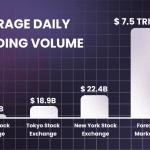The Essential Guide to Determine the Best Trading Strategies
Entering the world of trading can be intimidating, especially when it comes to choosing a trading strategy. This makes understanding how to determine the best trading strategies not just important, but essential. It’s all about finding a method that matches your goals, risk tolerance, and time commitment.
Selecting Strategies Based on Your Goals
Firstly, it is important to set and understand your trading goals. Are you looking for quick profits or willing to wait for long-term returns? A Day Trading strategy can offer the former, while a Swing Trading strategy can cater to the latter. Being clear on what you want out of trading will help cut down your choices and help you pick the best fit for you.
Risk Tolerance and Time Commitment
Secondly, risk tolerance plays a crucial role in selecting a strategy. Do you prefer taking large risks for potentially larger returns, or are you on the conservative side? Strategies such as Scalping or Position Trading can cater to different degrees of risk tolerance. Your available time commitment also plays a huge part here. Strategies like Day Trading require considerable time investment, whereas others like Long-term Trading strategies are less demanding.
Finding your Fit: Selecting the Best Trading Strategies according to your Risk Tolerance
Trading strategies are not unicorns; there’s no one-size-fits-all approach that will ensure success across the board for every trader. It’s imperative to identify a strategy that meshes well with your individual risk tolerance. Consider the impact of potential losses on your trading account and overall financial status. Listening to your instincts and understanding the nuance of your personal risk-versus-reward ratio will guide you towards a strategy that suits you best.
Evaluating your Risk Tolerance
Your risk tolerance is a measure of how much financial risk you are willing and able to withstand in the pursuit of profit. It’s essential to be self-aware and realistic about your financial situation and psychological comfort with loss. From high-risk, aggressive strategies to strategies that eliminate risk as much as possible, there is a wide range to choose from. Considering these factors carefully can point you towards the right direction in picking a strategy.
 Maximizing Profits: How Much Money Can a Trader Make in a Month?
Maximizing Profits: How Much Money Can a Trader Make in a Month?Choosing a Trading Strategy
When choosing a trading strategy, it’s key to align it closely with your risk tolerance. More risk-averse traders might lean towards long-term trading strategies, like buy and hold, that necessitate limited active management and can ride out market volatility. Alternatively, traders who are comfortable taking on more risk might find short-term strategies, such as day trading or scalping, more appealing as they offer the potential for significant returns but come with higher risk.
Adjusting your Strategy
Remember, selecting a trading strategy doesn’t mean you have to stick to it for life. For example, as you gain more experience and confidence, you might feel more comfortable taking on extra risk. Alternatively, changes in your personal or financial situation might lead you to opt for a more conservative approach. Always be prepared to adjust your trading strategy as your risk tolerance evolves.
Do’s and Don’ts: How to Avoid Common Mistakes in Implementing Trading Strategies
Implementing trading strategies effectively requires careful consideration of a number of factors. When done correctly, these strategies can significantly increase your profitability in the trading market. However, many traders fail to achieve success due to a number of common mistakes.
The Do’s
- Do maintain discipline: It’s vital to stick to your strategy once it’s in place. Consistency and discipline are key in maximizing your potential for success.
- Do keep track of your transactions: Keeping a detailed record of your transactions is essential, providing valuable insights on what works and what doesn’t in your trading strategies.
- Do be patient: Results take time and rushing the process can often lead to costly mistakes. Give your strategy time to yield results.
The Don’ts
- Don’t disregard the risks: No matter how sound your trading strategy is, always be aware of the inherent risks involved. Do not invest money you cannot afford to lose.
- Don’t let emotions dictate your decisions: Emotional trading is usually problematic. Make decisions based on clear analysis and stick to your pre-defined strategy.
- Don’t ignore the market trend: While it’s not always beneficial to follow the crowd, ignoring the market trend can be detrimental. Keeping track of market trends is important in anticipating future movements.
Delving Deeper: A Closer Look at the Best Day Trading Strategies
Day trading is a fast-paced, high-stakes form of stock trading that requires a diligent approach and the right strategy. The dynamic nature of the stock market often perplexes beginners, but an understanding of the most successful day trading strategies can help to pave the road to financial success.
One popular day trading strategy is Scalping. When you are scalping, you are trying to make many small profit trades, often within minutes. The key to this strategy’s success lies in the sheer volume of trades and the speed at which they are executed.
 Maximizing Profits: How Much Money Can a Trader Make in a Month?
Maximizing Profits: How Much Money Can a Trader Make in a Month? Maximizing Your Investment: How Many Bitcoins Can I Buy with 100 Euros?
Maximizing Your Investment: How Many Bitcoins Can I Buy with 100 Euros?Momentum Trading
A second effective strategy is Momentum Trading. Momentum traders seek out stocks that are moving significantly in one direction on high volume. The fundamental idea of this strategy is that once a trend is established, it is more likely to continue in that direction than to move against the trend.
Reversal Trading
The third day trading strategy worth exploring is Reversal Trading. Unlike momentum trading, reversal trading is based on the concept that the ‘tides will turn’. Traders utilizing this strategy are always on the lookout for stocks that have been rising or falling sharply and then show signs of leveling out.
Winning the Long Game: The Top Long-term Trading Strategies
In the realm of trading, success is not always determined by immediate profits. Instead, longevity and consistent growth are the real markers of a triumphant trader. Long-term trading strategies have been proven to be the most effective approach in achieving such success, offering both stability and substantial yields over extended periods.
Buy and Hold Strategy
The Buy and Hold strategy is the quintessential of long-term trading. It involves purchasing stocks or other securities and holding onto them for several years, allowing the value to gradually increase. An essential benefit of this strategy is that it mitigates short-term market volatility, thereby providing a more secure path to long-term financial growth.
Position Trading
Another highly-effective long-term strategy is Position Trading. This approach is based on comprehensive technical analysis and trend-following. In such an approach, traders hold a positon for lengthy periods, that could span over weeks, months or years, depending on the trend’s longevity.
 Maximizing Profits: How Much Money Can a Trader Make in a Month?
Maximizing Profits: How Much Money Can a Trader Make in a Month? Maximizing Your Investment: How Many Bitcoins Can I Buy with 100 Euros?
Maximizing Your Investment: How Many Bitcoins Can I Buy with 100 Euros? Exploring the Reasons: Why Am I Not Profitable in Trading?
Exploring the Reasons: Why Am I Not Profitable in Trading?Value Investing
Next, there is Value Investing. It emphasizes on identifying and investing in under-priced stocks that have the potential to increase in value over the long run. This method requires deep fundamental analysis to discover stocks that offer strong growth prospects.
